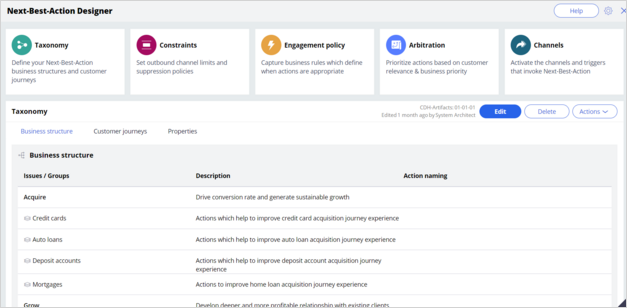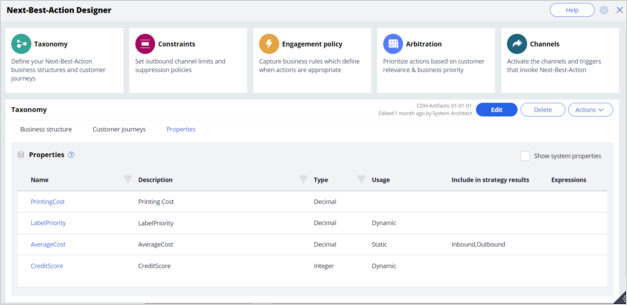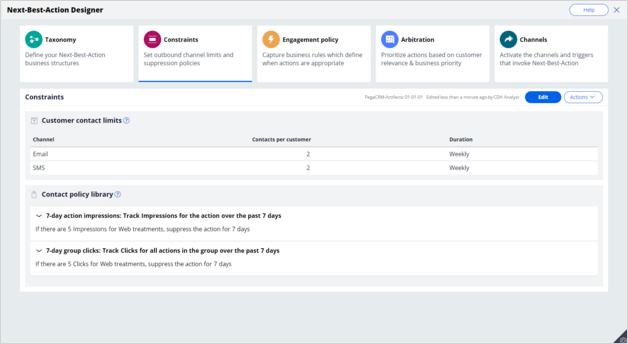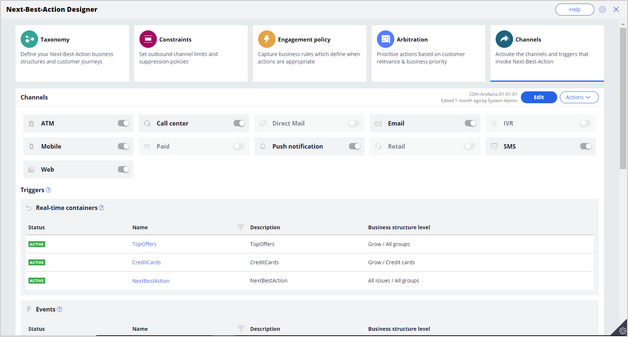
Next-Best-Action Designer
Introduction
Next-Best-Action Designer guides you through the creation of a Next-Best-Action strategy for your business. Its intuitive interface, proven best practices, and sophisticated underlying decisioning technology enable you to automatically deliver personalized customer experiences across inbound, outbound, and paid channels. Next-Best-Action Designer is organized according to the high-level sequence of steps needed to configure the next-best-action strategy for your organization.
Video
Transcript
Next-Best-Action Designer guides you through the creation of a next-best-action strategy for your business. Its intuitive interface, proven best practices, and sophisticated underlying decisioning technology enable you to automatically deliver personalized customer experiences across inbound, outbound, and paid channels.
Next-Best-Action Designer user interface allows you to easily define, manage, and monitor next best actions.
The tabs across the top of the user interface represent the steps to complete to define next best actions.
Use the Taxonomy component to define the business structure for your organization.
Use the Constraints component to implement channel limits and constraints.
Use the Engagement policy component to define the rules that control which actions are offered to which customers.
Use the Arbitration component to configure the prioritization of actions.
Use the Channels component to configure when and where the next best actions initiate.
The system uses these definitions to create an underlying Next-Best-Action Strategy framework. This framework leverages best practices to generate next-best-actions decision strategies at the enterprise level. These decision strategies are a combination of the business rules and AI models that form the core of the Pega Customer Decision Hub, which determines the personalized set of next best actions for each customer.
Use the Taxonomy tab to define the hierarchy of business issues and groups to which an action belongs and create and manage customer journeys.
A business issue is the purpose behind the actions you offer to customers. For example, actions with the purpose of acquiring new customers belong to the business Issue of Acquire. Actions with the purpose of retaining existing customers are grouped under the business issue of Retain.
Business groups organize customer actions into categories. For example, as part of the Acquire business Issue, you can create groups for products like credit cards, mortgages, or auto loans, with the intention of offering these to potential customers.
Customer journeys are the sum of the phases that customers go through when interacting with an organization. You can create customer journeys in Next-Best-Action Designer, and then map customer actions to different journey stages. Each stage represents an experience that a customer goes through while interacting with an organization.
On the Properties tab, you can define, manage, and view all the strategy result properties and action properties that are available in the application, including both default system properties and custom properties that you define for the outbound treatments or real-time containers.
Use Constraints to specify outbound contact limits and limit overexposure to a specific action or group of actions.
Outbound channel limits allow you to limit the number of outbound communications that a customer can receive over a given period of time on a specific channel. For example, you can decide that you do not want your customers to receive more than two emails per week or two SMS messages per week.
With action limits (outbound action limits and inbound action limits), you limit the number of actions that the customer sees during an interaction on an inbound or outbound channel.
On the Constraints tab of Next-Best-Action Designer, you can define more extensive suppression rules by creating Contact Policy rules in the library. Contact Policy rules are reusable across all Business Issues and Groups.
In the Contact Policy library, you define suppression rules that automatically put an action on hold after a specific number of outcomes are recorded for some or all channels. For example, an action can be suppressed for a customer for seven days after the customer has seen an ad for that action five times. Suppressing or pausing an action prevents over-exposure by limiting the number of times a customer is exposed to the same action.
Use Engagement policies to define when specific actions or groups of actions are appropriate for customers.
There are four types of engagement policies:
- Eligibility determines whether or not a customer qualifies for an action or group of actions. For example, an action may only be available for customers over a specific age or living in a specific geographic location.
- Applicability determines if an action or group of actions is relevant for a customer at a particular point in time. For example, a discount on a specific credit card may not be relevant for a customer who already owns a card.
- Suitability determines if an action or group of actions is appropriate for a customer for ethical or empathetic reasons. For example, a new loan offer may not be appropriate for a customer whose credit score is low, even though it might be profitable for the bank.
- Contact Policies determine when an action or group of actions should be suppressed and for how long. For example, you can suppress an action after a specific number of promotional messages have been sent to the customer. To activate Contact Policy rules created in the library on the Constraints tab, add them to the Engagement Policy tab.
Arbitration determines how Customer Decision Hub prioritizes the list of eligible and appropriate actions that come out of each group.
The factors weighed in arbitration are Propensity, Context weighting, Business value, and Business levers, each represented by numerical values.
- Propensity is the likelihood of a customer responding positively to an action. The propensity is calculated by AI. For example, clicking an offer banner or accepting an offer in the contact center are considered positive behaviors.
- Real-time contextual data is an important part of making highly relevant recommendations. Context weighting allows you to assign a weighting to a specific context value for all actions within an Issue or Group. For example, if a customer contacts the bank to change their address, the weight of the Service context increases, and the highest priority action is to ensure that the relevant service is delivered to the customer.
- Business value enables you to assign a financial value to an action and prioritize high-value actions over low-value ones. For example, promoting an unlimited data plan might be more profitable for the company than a limited data plan. Action values are typically normalized across Issues and Groups.
- Business levers enable you to accommodate ad hoc business priorities by specifying a weight for an action or group of actions and/or its associated business issue.
A simple formula determines a prioritization value, which is used to select the top actions.
The final priority indicates the top action selected from the list of eligible and appropriate actions for the customer. You can explore the arbitration matrix in Customer Profile Viewer to understand what type of actions are displayed to the customer.
You can use Customer Profile Viewer to examine specific profile and behavioral data, including previous next-best-action decisions and interaction history.
Next-Best-Action Designer enables the delivery of next best actions through inbound, outbound, and paid channels.
You can turn these channels on or off. If you turn off a channel, the next best actions are not delivered to that channel.
An external real-time channel is any channel that displays the actions that Customer Decision Hub selects for a customer. These channels can include a website, a call-center, or a mobile application. A real-time container is a placeholder for content in an external real-time channel.
A trigger is a mechanism whereby an external channel invokes the execution of a Next-Best-Action decisioning process for specific Issues and Groups. The result returns to the invoking channel. For example, when a real-time container called TopOffers is configured, the website invokes this real-time container before loading the account landing page.
As you have seen in this video, Next-Best-Action Designer is organized according to the high-level sequence of steps needed to configure the Next-Best-Action strategy for your organization. These steps involve:
- Defining the business structure for your organization.
- Implementing the channel limits and constraints.
- Defining the contact policies that control for which actions a customer qualifies.
- Configuring the prioritization of actions.
- Configuring when and where to initiate next best actions.
This Topic is available in the following Modules:
If you are having problems with your training, please review the Pega Academy Support FAQs.
Want to help us improve this content?






